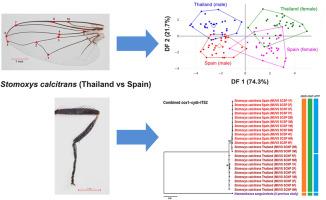Is Stomoxys calcitrans a single species? Morphometric and genetic perspectives from populations in Thailand and Spain
IF 1.7
Q3 PARASITOLOGY
Current research in parasitology & vector-borne diseases
Pub Date : 2025-01-01
DOI:10.1016/j.crpvbd.2025.100315
引用次数: 0
Abstract
Stomoxys calcitrans (Diptera: Muscidae) is a significant insect in the veterinary and medical fields. Previous studies have found a pronounced genetic divergence between populations from the Oriental region and those from other zoogeographical zones. Understanding the morphological and genetic variation within S. calcitrans populations is essential for clarifying the evolutionary processes underlying their structure across biogeographical regions. This study conducted geometric morphometrics on a total of 120 wings (30 per group: Thailand males, Thailand females, Spain males, and Spain females) to assess wing size and shape variations between S. calcitrans populations from Thailand (Oriental region) and Spain (Palaearctic region). Molecular analyses utilized two mitochondrial markers, cox1 and cytb, the nuclear marker ITS2, and a concatenated dataset of all three. Geometric morphometric analysis revealed statistically significant differences in wing size and shape (P < 0.05), although the classification accuracy based on wing shape was moderate (70%), indicating phenotypic plasticity rather than species-level differentiation. Phylogenetic reconstruction identified two well-supported genetic lineages. However, the results from the species delimitation methods (Assemble Species by Automatic Partitioning, Automated Barcode Gap Discovery, and multi-rate Poisson Tree Processes), low interpopulation divergence, and a shared haplotype all verify that these lineages represent a single, globally distributed species. Further neutrality tests and mismatch distribution analyses revealed that the Oriental population has a deeper evolutionary history, while the European population likely arose from a more recent colonization event. These findings demonstrate the influence of historical biogeographical processes in shaping the global genetic structure of S. calcitrans and underscore the importance of broader geographical sampling to fully elucidate its evolutionary history.

是一个单一的物种吗?泰国和西班牙种群的形态计量学和遗传学观点
狭口蝇(双翅目:蝇科)是兽医学领域的重要昆虫。先前的研究发现,东方地区的种群和其他动物地理区域的种群之间存在明显的遗传差异。了解石菖蒲种群的形态和遗传变异,对于阐明其跨生物地理区域结构的进化过程至关重要。本研究对总共120只翅膀(每组30只:泰国雄性、泰国雌性、西班牙雄性和西班牙雌性)进行了几何形态测量,以评估来自泰国(东方地区)和西班牙(古北地区)的S. calcitrans种群之间翅膀大小和形状的差异。分子分析利用了两个线粒体标记,cox1和cytb,核标记ITS2,以及这三个标记的串联数据集。几何形态计量学分析显示,尽管基于翅膀形状的分类准确率中等(70%),但翅膀大小和形状的差异具有统计学意义(P < 0.05),这表明了表型可塑性而不是物种水平的分化。系统发育重建确定了两个得到良好支持的遗传谱系。然而,物种划分方法(通过自动划分组装物种,自动条形码间隙发现和多速率泊松树过程)的结果,低种群间差异和共享的单倍型都验证了这些谱系代表一个单一的,全球分布的物种。进一步的中性测试和错配分布分析表明,东方种群具有较深的进化历史,而欧洲种群可能起源于较近的殖民事件。这些发现证明了历史生物地理过程对形成石菖蒲全球遗传结构的影响,并强调了更广泛的地理采样对充分阐明其进化史的重要性。
本文章由计算机程序翻译,如有差异,请以英文原文为准。
求助全文
约1分钟内获得全文
求助全文

 求助内容:
求助内容: 应助结果提醒方式:
应助结果提醒方式:


